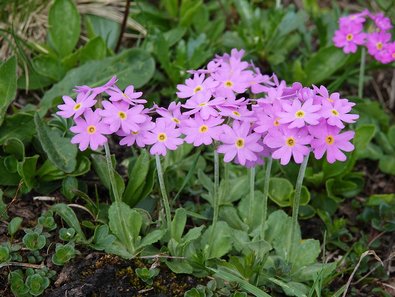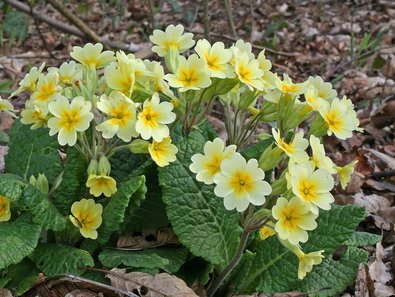The primrose family (Primulaceae) currently comprises 58 genera with around 2600 species, which occur worldwide from permafrost regions to the tropics. Switzerland is home to ten genera from this family. In addition to the family's namesake genus, the primroses (Primula), the best-known representatives are the snowbells (Soldanella), rock jasmine (Androsace), sowbread (Cyclamen) and loosestrife (Lysimachia).
With around 630 species worldwide, the primroses are the most species-rich genus in the family. Most species are herbaceous and perennial, as they form underground rhizomes. Primroses have their main centre of distribution in the northern hemisphere, with most species being found in the Himalayas.
There are also over 60 accepted hybrids, some of which are fertile, which have been created either in nature or by crossing in nurseries. Primroses are popular garden and ornamental plants due to their attractive inflorescences and often long flowering period. The bastard auricula (P. ×pubescens) is a parent form of many primula varieties. It originated in nature through a crossing of the lime-loving auricula (P. auricula) and the hairy primrose (P. hirsuta), which grows on silicate.
Fig. 1. Two representatives of primroses from higher altitudes and the Alps: on the left the mountain cowslip (Primula auricula), also known as the bear’s ear; on the right the hairy primrose (Primula hirsuta). Both species are mostly found on rocks, the mountain cowslip on calcareous sites and the hairy primrose on sites low in lime. Photos: Thomas Reich (WSL)
The two best-known primroses
When people in German-speaking countries talk about “cowslips” or “cowslip primroses”, they are usually referring to the common cowslip (P. veris) or the similar oxlip (P. elatior). The colloquial name in German, literally meaning “key flower” is probably due to the shape of the inflorescences, which, with a lot of imagination, resembles an upright key with a split bitting. Similarly in English, they have been called “St. Peter’s keys” or “keys of heaven”, because their flowerheads look like a set of keys. In numerous legends and fairy tales, this miracle flower is said to open mysterious doors, chests and even rocks or mountains – to reveal treasure.
For centuries, cowslips have also played an important role as medicinal plants. Because of their high saponin content, the dried flowers or the rhizomes are often processed to make expectorant cough mixtures or juices for colds. A regular steam bath made from an extract of the flowers is also said to strengthen connective tissues. Caution is however advised with various glandular species, the secretions of which can trigger allergic skin reactions or lead to nausea and vomiting when ingested.
However, primroses are not only useful for us humans. Many insects are also dependent on them. For example, the oxlip serves as an important food plant for some caterpillar and butterfly species. Bees, bumblebees and other insects are grateful for the food source early in the year. Because of the species’ long corolla tube however, only long-tongued species such as bumblebees and butterflies are suitable as pollinating insects. Bees do however often use a trick to get to the nectar: they simply bite a hole in the crown tube from the outside.
Fig. 4. The bird’s-eye primrose (Primula farinosa, left) occurs particularly near the Alps on fens and calcareous, moist soils. The stemless cowslip or stemless common primrose (Primula acaulis or Primula vulgaris, right) grows in Switzerland mainly in the western parts of the country and in Ticino, and in Germany mainly in Schleswig-Holstein. Photos: Thomas Reich, Ulrich Wasem (both WSL)
Video on cowslips (in German)
Literature
- Lauber K, Wagner G, Gygax A (2018) Flora Helvetica – Illustrierte Flora der Schweiz. 6. Aufl. Haupt Verlag, Bern.
- Stevens, P. F. (2023) Angiosperm Phylogeny Website. (Zugegriffen am 30.3.2023)
- WFO (2023) World Flora Online. (Zugegriffen am 30.3.2023)
Translation: Tessa Feller






